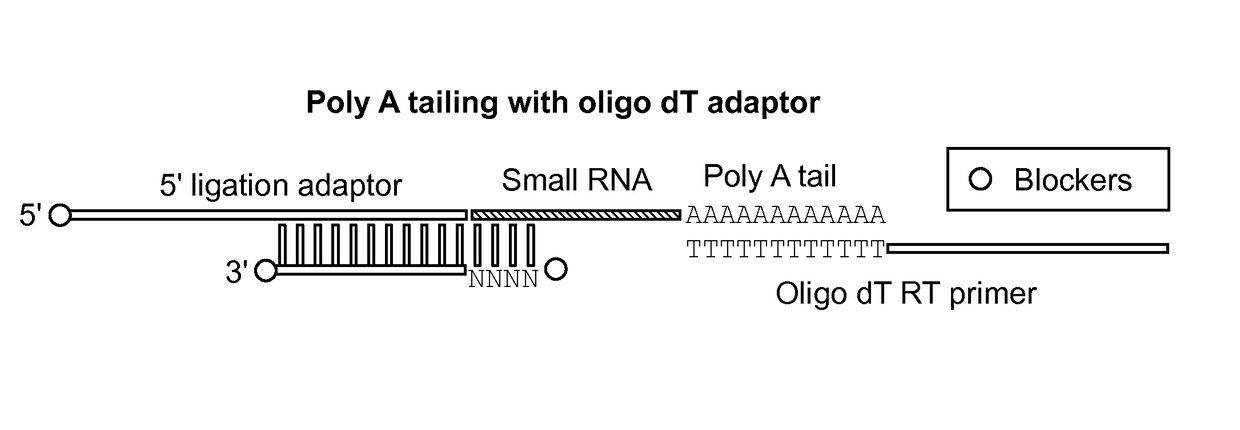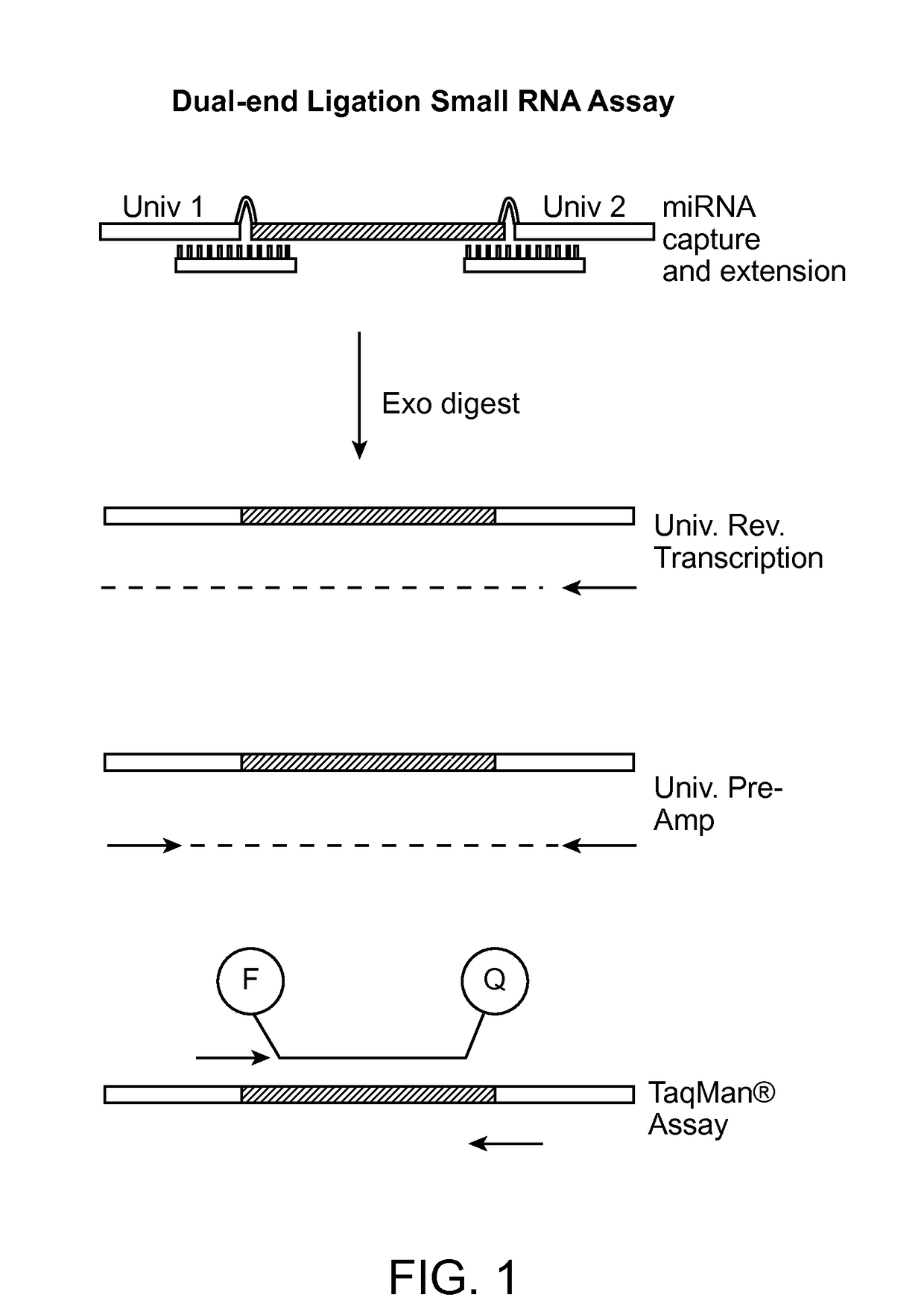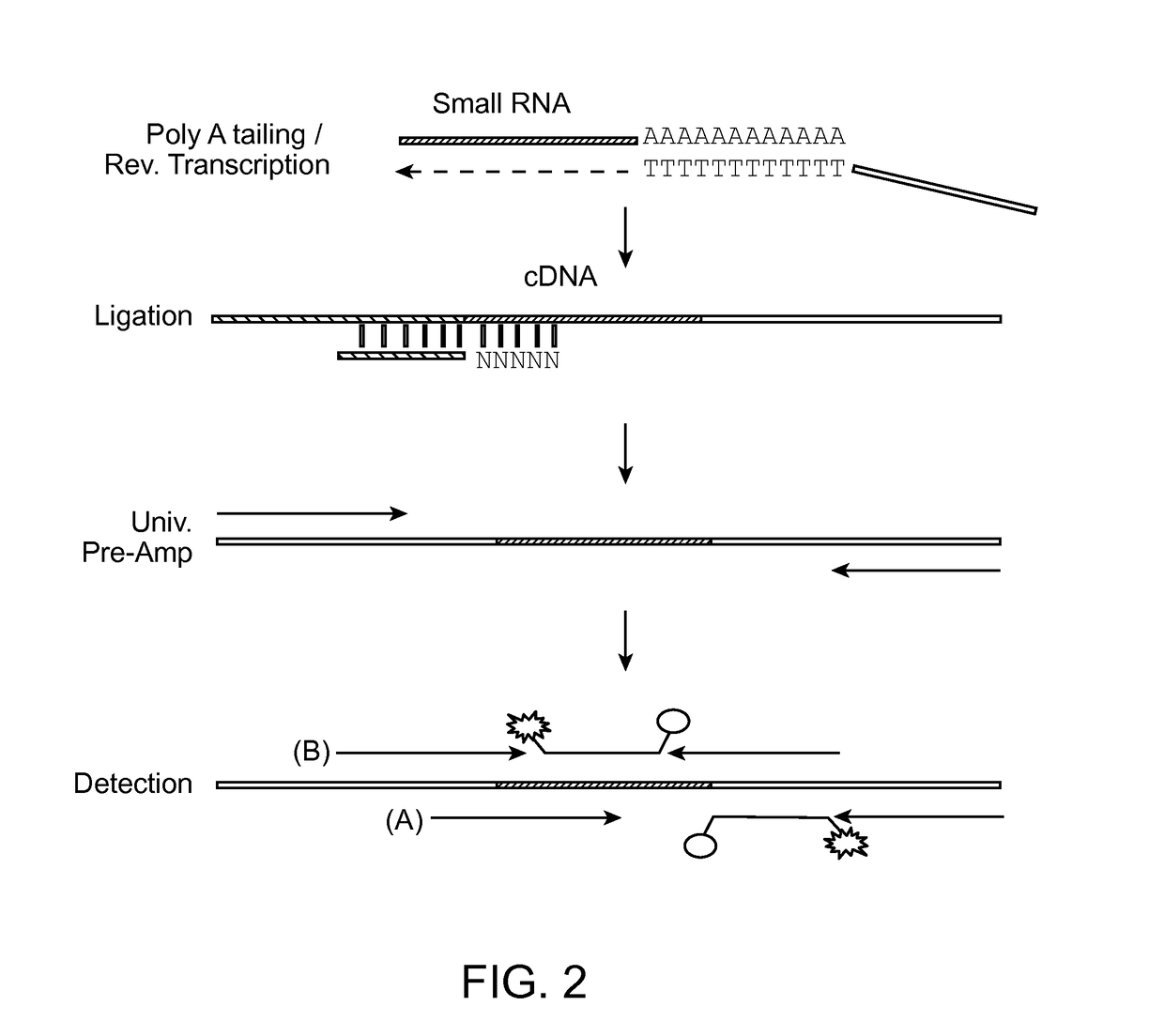Small RNA capture, detection and quantification
a small, rna technology, applied in the field of molecular and cell biology, can solve problems such as methods that are less than ideal, and achieve the effects of reducing target-specific biases, eliminating target number restriction, and simplifying manufacturing
- Summary
- Abstract
- Description
- Claims
- Application Information
AI Technical Summary
Benefits of technology
Problems solved by technology
Method used
Image
Examples
example 1
lysis Using Dual-End Ligation-Based RT-qPCR (3-Step Method)
[0182]Total RNAs from human brain were obtained from Ambion® (Carlsbad, Calif.). Ligation adaptor, primer and synthetic oligonucleotides were purchased from Integrated DNA Technologies (IDT, Coralville, Iowa). TaqMan® assays were obtained from Applied Biosystems® Custom Gene Expression Laboratory.
[0183]Ligation Reaction
[0184]The ligation reaction was performed to ligate the 5′ and 3′ ligation adaptors to the miRNA in the presence of the 5′ and 3′ ligation splints with semi-degenerate overhangs. The ligation reaction was performed by combining the following components:
[0185]
2 μl 5 × Adaptor Mix5 μl 2 × Ligation Buffer1 μl 10 × Ligation Enzyme Mix2 μl total RNA ranging from 2 pg to 20 ng10 μl Total ligation reaction volume
[0186]The ligation reaction mix was mixed, spun briefly, and incubated in a thermal cycler at 37° C. for 30 min.
[0187]Reverse Transcription Reaction
[0188]The reverse transcription (RT) step allows synthesis o...
example 2
lysis Using Dual-End Ligation-Based RT-qPCR (2-Step Method)
[0205]Two-step methods were performed essentially as described in Example 1, except that either the ligation and RT steps or the RT and pre-amplification steps were combined.
[0206]The “2-in-1” combined ligation / RT method was performed by combining the miRNA with the following components: 5′ ligation adaptor, 5′ ligation splint, 3′ ligation adaptor, 3′ ligation splint, universal RT / reverse primer, T4 ligase, reaction buffer, SuperScript® III, and nuclease-free water. Pre-amplification and PCR were performed as in Example 1 with the ligation-RT product. As can be seen in FIG. 11 in the combined ligation / RT 2-step method, the titration of the synthetic template showed at least a 4- to 5-log linear dynamic range using an hsa-let-7a assay with blocking oligonucleotide (solid diamonds) or without blocking oligonucleotides (solid squares).
[0207]The “2-in-1” combined RT / pre-amp method was performed by combining the ligation product ...
example 3
lysis Using Dual-End Ligation-Based RT-qPCR (1-Step Method)
[0208]A “3-in-1” method was performed by combining the miRNA with the following components: a 5′ ligation adaptor, a 5′ ligation splint, a 3′ ligation adaptor, a 3′ ligation splint, universal forward primer, universal RT / reverse primer, ligase (T4 ligase), reverse transcriptase (SuperScript® III) and AmpliTaq® Gold DNA polymerase. The reaction was stopped after RT by heating the mixture to 99° C. for 10 minutes. For comparison, a separate ligation and reverse transcription protocol (according to standard methods) was used as a control (FIG. 13, diamonds) to compare to the performance of the 3-in-1 method (FIG. 13, squares) using 45 miRNA templates. As can be seen in FIG. 13, both methods are comparable.
[0209]Serial dilutions of 48 template miRNAs were used to test the 3-in-1 method for sensitivity and dynamic range (see, FIG. 14). Pre-amp #1, 2, 3 as labeled along the x-axis indicates the different amount of universal RT / rev...
PUM
| Property | Measurement | Unit |
|---|---|---|
| Tm | aaaaa | aaaaa |
| Tm | aaaaa | aaaaa |
| Tm | aaaaa | aaaaa |
Abstract
Description
Claims
Application Information
 Login to View More
Login to View More - R&D
- Intellectual Property
- Life Sciences
- Materials
- Tech Scout
- Unparalleled Data Quality
- Higher Quality Content
- 60% Fewer Hallucinations
Browse by: Latest US Patents, China's latest patents, Technical Efficacy Thesaurus, Application Domain, Technology Topic, Popular Technical Reports.
© 2025 PatSnap. All rights reserved.Legal|Privacy policy|Modern Slavery Act Transparency Statement|Sitemap|About US| Contact US: help@patsnap.com



